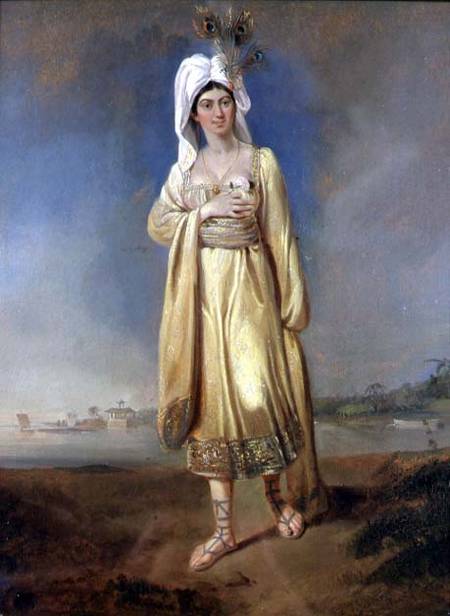 |
| Princess Caraboo - by Edward Bird |
It seems only fitting that my first proper blog post, and the first story I chose to share, is about a woman whose story resonated with me from the first time I saw Edward Bird’s painting of her. Standing amidst the Bristol based paintings in my local museum (the much loved Bristol Museum and Art Gallery), the portrait is perhaps nothing special and easily overlooked unless you know the story behind it or have read the all important explanation beside it.
So who is she?
An unknown foreigner?
The Princess of Javasu?
Or a woman from the moon?
She was all these things and more, for some six weeks in 1817. Found wondering into Almondsbury, a village not many miles away from Bristol, was a fatigued unknown foreigner, who refused all gifts of money, and communicated only in gestures, understanding not a word that was said to her and speaking a language no one could understand.
She ended up being taken in by the local magistrate and his wife and it was eventually believed, at least according to the press, that she had been kidnapped by pirates, ill-treated on board their ship and had jumped ship at the sight of land, swimming to shore from the Bristol Channel. For six weeks she was watched, studied and discussed by members of Bristol’s intellectuals and middle class society, even fascinating the fashionable Bath society for one single day. She seemed to inhibit all that was fascinating about the Orient, the Other; foreign cultures and people that enthralled the people of Britain. She ‘swam like a fish’, fenced with a sword in one hand and a dagger in the other, ate curry, refused all spirits and alcohol, drinking only water (which was strange for the time). She worshiped the sun, shrunk away from male touch and said her name was “Caraboo! Caraboo!”.
She was beautiful and enigmatic, but more importantly she was exotic. The people of early nineteenth century were lured by images and ideas of the Orient and the east, which they only knew through paintings and engravings, exhibited in galleries or published in newspapers and periodicals. They heard about the foreign through the second and third hand stories of those who had traveled there, or through the things they brought back and the commodities the east inspired. Princess Caraboo’s story had all the excitement of the Arabian Nights, translated and read also at that time, or the exuberant pantomimes such as Aladdin or The Sultan put on in theatres across England.
She was real, an exotic eastern royal, in their midst, in the home of one of their own. She could be seen, touched, an attempt at conversation could be made. She was all that entranced them about the orient and she was here, in their own country.
Of course she wasn’t who she said she was. With the increasingly powerful press creating an aura of celebrity around this unknown foreigner, she was recognized. Princess Caraboo was in fact a Miss Mary Baker, one time servant, a vagrant and wonderer, a member of the lower classes, a girl from Witheridge, Devonshire. Media attention still surrounded her and the hoax, discussion of her and the case was published periodically throughout the century and into the next. Her deception fascinated many, ships and race horses were named after her, she inspired ballads, books, and a film. She even inspired a twenty year old Bristol girl in 2010 to throw herself into research, reading newspaper articles of the day and spending hours reading in the library surrounded by towering books on the period all so she could write one 10,000 word dissertation on her.
She truly was an amazing woman of her day – I almost can’t believe she managed to pull off her deception, speaking only gibberish and talking to no one for some six weeks! I’m I shall write more than this potted description of what happened, there are so many things that make her case interesting to discuss and think about. But that will have to wait until another day.





